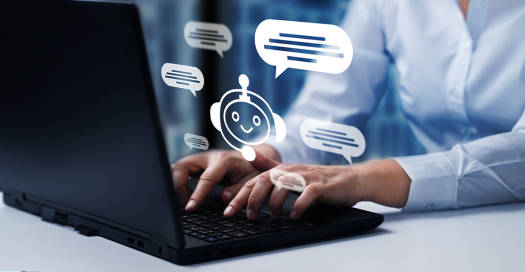Eleviant is to Elevate & Scale. Eleviant Tech symbolizes business transformation and reinforces our mission to help clients elevate and scale their business.
Everything You Want to Know About Healthcare Chatbots
September 2, 2020
Travis McCallum

If you are a doctor short-staffed in your private practice, this post is for you. If you are an IT Director or CIO wondering how to scale your communication efforts with the growth of new patients, nurses, and doctors in the hospital, then this post is for you.
“Ninety percent of hospitals still use pagers for clinical communications,” according to HIMSS Analytics. “These systems cost roughly 45 percent more than hospitals would pay for smartphone-based unified communications. Worse, they slow clinicians down and can delay patient care.”
It’s 2020 and with the COVID-19 pandemic in full swing, healthcare professionals are desperate for working solutions that can help solve their toughest problems including communicating better with their team members, their patients, and beyond.
To remedy this important piece of the puzzle, chatbots will show you all about how a virtual assistant can drastically improve your mode of communication.
Our Healthcare Chatbots Defined
If you can imagine your trip to a clinic for a moment. The first person you meet at the front desk is the receptionist. Someone who is kind, friendly, helpful, and inquires your reason for visiting. You could be anyone—a prospective patient looking to schedule an appointment or are arriving for one. Whatever the reason for your visit, the receptionist is there to sort it out and guide you to the best outcome available.
In its essence, the chatbot is one and the same with the receptionist. Operating as a virtual agent to service others, chatbots help with incoming questions and direct people to their intended reasons for coming to the hospital that day.
For a broader definition of the technology behind chatbots, be sure to read this article summarizing the natural language processing (NLP) and artificial intelligence (AI) behind the bot.
But for the sake of today’s healthcare context, let’s talk about three primary chatbots that serve our doctors, nurses, and patients.
Virtual Communication Using AI in Healthcare Today
Whether you are trying to secure new business by bringing in more patients or just trying to accommodate schedules for everyone’s sanity, leaving a lasting impression that doesn’t tarnish your healthcare reputation is a key ingredient to good communication.
The first of our chatbot use cases looks at the patient experience. If patients can’t get through to their doctor in a timely manner, they are likely to take their health needs to somewhere that will be responsive and engaging. The last thing you want is to lose business because you can’t connect with your patients.
“There’s a strong correlation between how long a patient had to wait and the star rating of the healthcare facility,” according to the 2018 Vitals study. “Physicians with the highest rating had an average wait of just over 13 minutes while those with the lowest ratings had average wait times of more than 34 minutes.”
Here’s where chatbots make a difference.
The receptionist in the office is making a call 1-to-1 and can’t manage multiple inquiries at once. But the chatbot can…
- Respond to direct text messages
- Respond to website visits
- Respond to social media
As an example, you have 3 patients with three different needs simultaneously contacting your clinic. Callan isn’t sure if he is sick enough to warrant a visit, so he texts your office his symptoms. The chatbot cross-references the supplied symptoms with your medical database and makes an educated decision on whether Callan should schedule an appointment or follow a set of at-home care instructions.
At the same time, Cara has come down with the flu and needs medication to recover. She connects with the chatbot on your website and jumps straight to schedule an appointment. After gathering details for the reason for the appointment, the chatbot reviews available timeslots in the clinic EHR scheduling system and prompts Cara for a convenient time to come into the office.
Finally, Connor noticed a problem in his last billing statement and wants to correct some of the charges on his account. Rather than go through hoops of reroutes to find the appropriate department, the chatbot facilitates the whole process by directing Connor to the right place at the right time.
In all three instances, the chatbot can ask patient feedback on the clinic quality. This data is shared directly with you to learn and improve upon existing operations within the company.
Keep Your Information Flowing Freely
Use case number two is about information flow. Take Emergency Medicine Resident Caroline Schulman’s story about how she had to contact each patient that contracted COVID-19 through her hospital’s test and the emotional toll it took to muster the strength in each call.
“At the beginning, there was no system for managing questions from the public about Covid-19. Calls about it to the emergency department were routed to me. The hospital and the city quickly built the infrastructure to tackle these difficult inquiries. Within days, our faculty practice had partnered with the city to create a hotline that referred patients to a telemedicine consultation that would result in a test for Covid-19 when appropriate.”
Your employees are hard at work and you should always be looking for ways to offload their plates and ease the burden. While there are some tasks that can only be done by human beings, those that can be automated should let chatbots do some of the more repetitive work.
In Caroline’s example, she is working off a script with a series of pre-defined questions and answers that can easily be taken up by a chatbot to drive the results of COVID-19 positive cases.
Remember earlier, we talked about how human interaction is often 1-1, whereas a single chatbot can engage simultaneously at scale. This works for internal communication too.
When a staff member updates a patient record in their Electronic Health Record (EHR), chatbots make it easy for any internal employee to filter to the information they need. As a doctor, you could possibly see hundreds of patients in each day, and trying to memorize all their health conditions can feel impossible.
With your own virtual assistant (chatbot), you simply just must ask it what you want to know.
- Why is the patient coming in today?
- What symptoms is the patient reporting?
- What did the patient come in for last time they were here?
Having a chatbot as your virtual assistant helps everyone in the clinic manage their time and energy more efficiently by improving the information flow through real-time and accurate engagement.
Connect with Patients Beyond Their Visit
Communication does not just stop after a hospital visit. In fact, one of the number one challenges patients face in their recovery is following doctor’s orders. People sometimes need accountability to help them manage their restoration whether that be medication reminders, a follow-up check-in, or even a mental health diagnostic for peace of mind.
You can go the extra mile as a healthcare professional by holding a patient’s hand well after their visit by using a chatbot to continue to engage. Think of it as a mini therapist, a bundle of positivity rolled up into a digital companion.
Many successful hospitals and clinics have created their own mobile apps their patients use to handle their healthcare needs. When you add a chatbot, you can set intervals throughout the patient’s day to have notifications remind them of what their personal journey requires.
Expanding on daily chat includes preventive measures too. While chatbots should not be treated as a complete medical expert, they can certainly provide tips and tricks for proper diet and exercise.
Manage Your Communication Better
The wonderful world of chatbots in healthcare is solving major communication hurdles that are bogging down short-staffed teams with a renewed sense of management. Patients are gaining immense value from the engagement that says, “We Care!” You are providing a service that goes above and beyond excellence in the right time at the right place.
As one final statistic in closing, did you know that many adults now prefer to send/receive a text instead of making/receiving a phone call? 98 percent of text messages are read. When you consider how responsive people are to text, it’s a big encouragement to know that chatbots fill this mainstream spot quite nicely.
If you are interested in learning more about chatbots, be sure to visit vChat and play around with some of our demonstrations. There are some very relevant and interesting conversations you can have, which might just spark the need you are looking for.
Get in touch with our Digital consultants to Elevate & Scale your business
Free ConsultationReady to get interesting insights of Eleviant? Subscribe to our Newsletter
SubscribeRelated Posts
Digital Transformation
Emerging Tech
vChat
How to Protect Against Chatbot Abuse
Get in touch with our Digital consultants to Elevate & Scale your business
Free ConsultationReady to get interesting insights of Eleviant? Subscribe to our Newsletter
Subscribe
















































